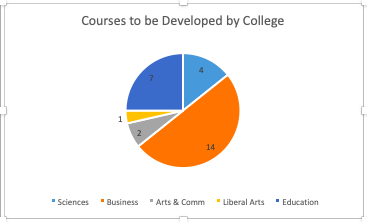What is Assessment?
Assessment is a tool used to gather information about what and how students learn in relation to current education standards and to compare that information across populations (Lynch, 2018). Generally in the United States, those benchmarks or standards are established by the government with little input from front line educators. This is a point of contention with teachers who are often over-tasked and under-supported. Assessment can take many forms- traditional assessments such as multiple choice, fill-in-the-blank, short answer questions, essays, and research papers; more modern assessments such as online discussion boards and peer reviews; and even performance assessments such as digital presentations, and individual- and group-created videos. Course- and module (lesson)-level objectives must be aligned to every gradable event. Backward design is often used in determining which objectives align to which assessments. Accounting for individual differences in students such as cultural diversity, socioeconomic background, and support at home is something teachers believe is important, yet struggle with given available resources.
Reference
Lynch, M. (2018). The real purpose of assessments in education. Retrieved from https://www.theedadvocate.org/real-purpose-assessments-education/
Open-ended, Selected-response, or Performance?
Which kind of assessment is better? The answer is, that depends. Students have diverse experiences, needs, and skills and thus have a variety of learning and assessment preferences. Some students are very good at taking selected-response test or can become good at taking this type of test by learning strategies for multiple choice questions (Hieck, 2019).. This does not mean they necessarily have a grasp on the content, but rather they are skilled at selecting the correct response from several options. Some students are more skilled at writing and perform well when they are tasked with writing essays or short responses to open-ended questions. There are also students who like to be center stage. Performance assessments such as presentations in class or online appeal to them and they thrive in those situations. Ideally, a combination of assessment strategies should be used to allow as many students as possible to shine.
Reference
Heick, T. (2019). The real problem with multiple choice questions. Retrieved from https://teachthought.com/technology/the-real-problem-with-multiple-choice-questions/
Effort Grades
Effort grades often have a negative connotation. Rewarding effort can balance performance or test anxiety (Stitt & Pula, 2014). Not completion grades, effort grades serve to quantify student persistence and resilience and provide an opportunity to reward students for sticking with a process and trying even with they do not end up with the correct answer. This growth mindset thinking encourages students (and teachers) to see challenges through even when they are difficult, to persevere even when students feel like giving up. This encouraging behavior not only helps students with school work, but also with challenges outside of school. A growth mindset learned as a child can be beneficial throughout a student’s entire life.
Reference
Stitt, J. L., and Pula, J. J. (2014). Voting for subjectivity: Adding some gray areas to black-and-white, objective grading practices. Delta Kappa Gamma Bulletin, 80(3), 24–27. Retrieved from http://search.ebscohost.com/login.aspx?direct=true&AuthType=sso&db=a9h&AN=95338949&site=ehost-live
Self Assessment
Self-assessment is an important tool in education. When students are able to check their own understanding and receive quick feedback, they are able to identify what they do not know, make adjustments to what they are doing and do something different next time (Stanford University, 2019). Self-assessment can be used by students to track their own progress, help set goals, and identify where focus should be placed. Self-assessment can begin with young children and checklists. Perhaps a precursor to the rubric, a simple checklist allows students to understand what they should be paying attention to in their work. In middle and high school, students can be involved in creating rubrics and assessments. This kind of input allows students to take ownership of their education experiences and contribute to some education decisions.
Reference
Stanford University. (2019). Student self assessment. Retrieved from https://teachingcommons.stanford.edu/resources/teaching/evaluating-students/assessing-student-learning/student-self-assessment
Student Growth Portfolios
Student growth portfolios allow students to create work and curate it over time so that growth can be observed. When goal setting is incorporated, these portfolios can truly be long term planning tools that show students how the work they do now can impact the future. This student-centered development process can be implemented utilizing web-based tools such as Portfolium which provides a template and hosting, helping to lower the technology requirement for teachers unless they wish to create something more complicated than the basic template (Laurent Clerc National Deaf Education Center, 2015, Instructure, 2019) . Portfolios for individuals, small groups, and classes can be created there. A potential shortcoming is the small need for training for use of other than the basic templates.
Reference
Instructure. (2019). Portfolium [Web-based software]. Retrieved from https://portfolium.com/
Laurent Clerc National Deaf Education Center. (2015). Portfolios for student growth. Retrieved from https://www3.gallaudet.edu/clerc-center/info-to-go/educational-resources/portfolios-for-student-growth.html
The Use of Figures in Assessment
Assessment data can be complex and even confusing at times. Sometimes the volume of data alone is intimidating and off-putting. The use of visual representations when sharing information about assessment data can make the data more accessible to a wider range of stakeholders. Data can easily be utilized to create graphs and charts using software such as Microsoft Excel. The figure at the top of this post shows a simple pie chart indicating the number of online courses to be developed by college at West Liberty University.
Reference
Kefauver, L. (2019). Courses to be developed by College [Chart] (unpublished). West Liberty University
Parent-Teacher Conferences
The parent-teacher conferences is a tool used not only to report on student grades and behavior, but also to solidify communication and connections between home and school by building trust (Ediger, 2016). Students should play a part in the parent-teacher conference so that they can benefit from the example set by the adults in their lives and so that they may contribute to the conference. Contributing to the content of the parent-teacher conference allows students to lead, in an age appropriate way, and to be a real partner in the home-school relationship.
Reference
Ediger, M. (2016). Quality parent teacher conferences. College Student Journal, 50(4), 614–616. Retrieved from http://search.ebscohost.com/login.aspx?direct=true&AuthType=sso&db=a9h&AN=120245396&site=ehost-live
Feedback
Students crave feedback. They want and need effective, specific guidance in making improvements to their work. It is up to teachers to provide that feedback in a way that encourages students, praises what they are doing well, provides detailed information about what they are not doing well including suggestions about how to enhance future work, in a timely manner. Feedback tailored especially for those students in a lower performance group can help them make real strides in learning. (Paschold, Huber, Zeißig, Lang, & Kneist, 2014). Feedback can be provided in writing, or in video or audio formats. Some online instructors like to use audio or video feedback as they feel it builds the learning community.
Reference
Paschold, M., Huber, T., Zeißig, S., Lang, H., & Kneist, W. (2014). Tailored instructor feedback leads to more effective virtual-reality laparoscopic training. Surgical Endoscopy, 28(3), 967–973. https://doi.org/10.1007/s00464-013-3258-z
Tools of the Trade: Rubrics
Rubrics are this blogger’s favorite tool in the education toolbox. Rubrics help create a partnership between students and teachers in that the students know what is important to the teacher as soon as an assignment is introduced. When students know what is expected in an assignment, they are more likely to meet, or even exceed, the requirements. Rubrics are particularly beneficial to students as the use of them adds objectivity to the evaluation process. The structure of a rubric helps those evaluating student work to use the established criteria rather than relying on intuition to make a quick assessment about the work (Tai, Ajjawi, Boud, Dawson, & Panadero, 2018).
Reference
Tai, J., Ajjawi, R., Boud, D., Dawson, P., and Panadero, E. (2018). Developing evaluative judgement: enabling students to make decisions about the quality of work. Higher Education (00181560), 76(3), 467–481. https://doi.org/10.1007/s10734-017-0220-3








